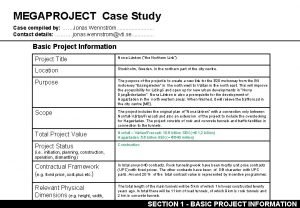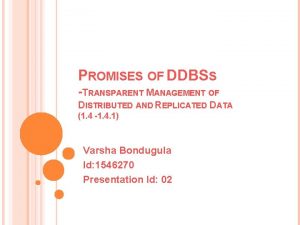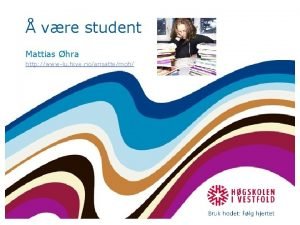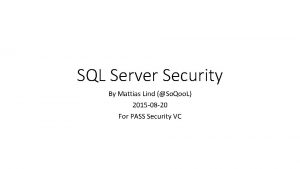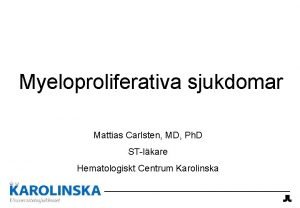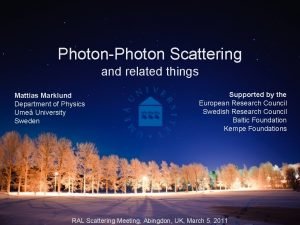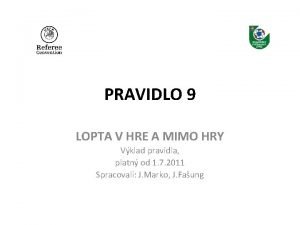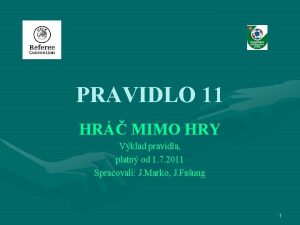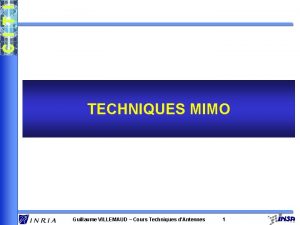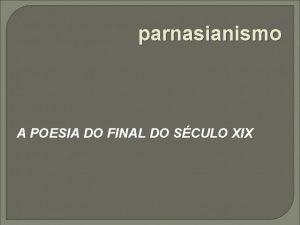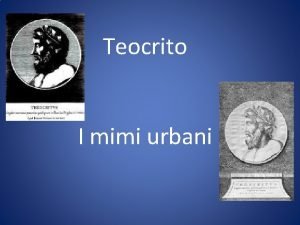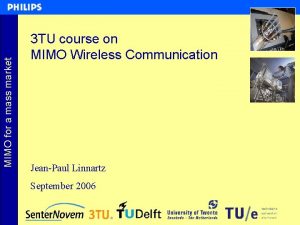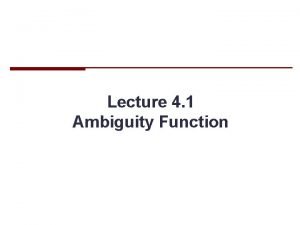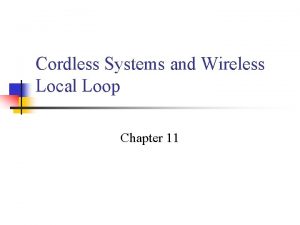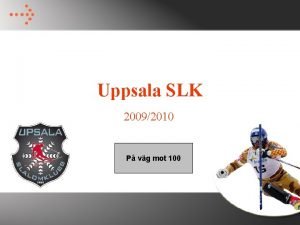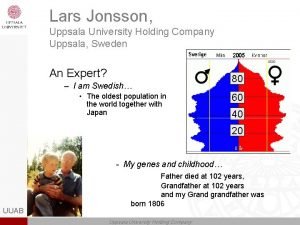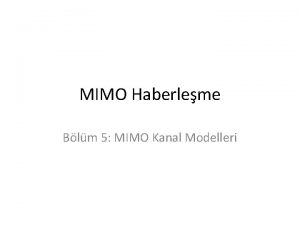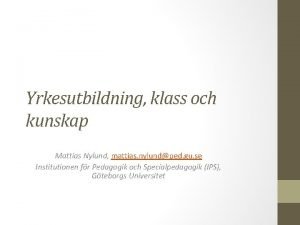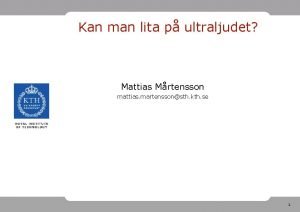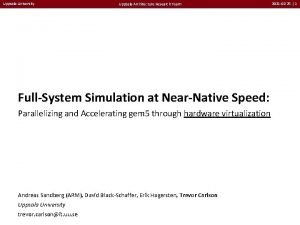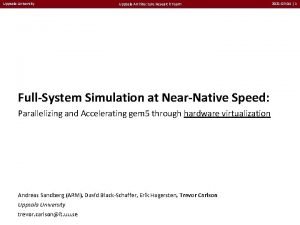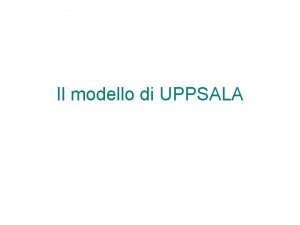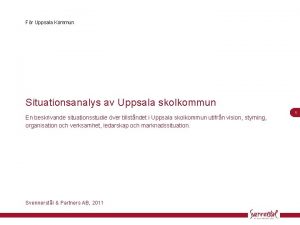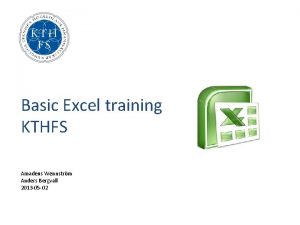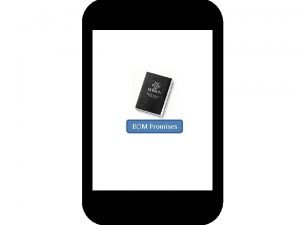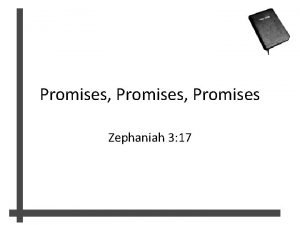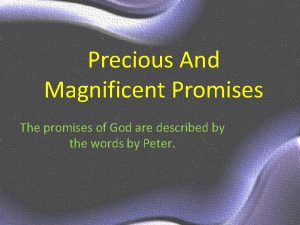Promises of Wireless MIMO Systems Mattias Wennstrm Uppsala




![”Classical” receive diversity H 11 H 21 = log 2[1+(PT/s 2)·|H|2] Mattias Wennström Signals ”Classical” receive diversity H 11 H 21 = log 2[1+(PT/s 2)·|H|2] Mattias Wennström Signals](https://slidetodoc.com/presentation_image/435900495b56bd1dc8030bb9156cd7dd/image-5.jpg)




















- Slides: 25

Promises of Wireless MIMO Systems Mattias Wennström Uppsala University Sweden Mattias Wennström Signals & Systems Group

Outline • • Introduction. . . why MIMO? ? Shannon capacity of MIMO systems Telatar, AT&T 1995 The ”pipe” interpretation To exploit the MIMO channel – BLAST Foschini, Bell Labs 1996 – Space Time Coding Tarokh, Seshadri & Calderbank 1998 – Beamforming • Comparisons & hardware issues • Space time coding in 3 G & EDGE Release ’ 99 Mattias Wennström Signals & Systems Group

Why multiple antennas ? ? • Frequency and time processing are at limits • Space processing is interesting because it does not increase bandwidth outdoor ”Specular” ”Scattering” channels indoor Phased array range extension, interference reduction Mattias Wennström Signals & Systems Group Adaptive Antennas interference cancellation MIMO Systems (diversity)

Initial Assumptions • • • Mattias Wennström Signals & Systems Group Flat fading channel (Bcoh>> 1/ Tsymb) Slowly fading channel (Tcoh>> Tsymb) nr receive and nt transmit antennas Noise limited system (no CCI) Receiver estimates the channel perfectly We consider space diversity only
![Classical receive diversity H 11 H 21 log 21PTs 2H2 Mattias Wennström Signals ”Classical” receive diversity H 11 H 21 = log 2[1+(PT/s 2)·|H|2] Mattias Wennström Signals](https://slidetodoc.com/presentation_image/435900495b56bd1dc8030bb9156cd7dd/image-5.jpg)
”Classical” receive diversity H 11 H 21 = log 2[1+(PT/s 2)·|H|2] Mattias Wennström Signals & Systems Group [bit/(Hz·s)] Capacity increases logarithmically with number of receive antennas. . . H = [ H 11 H 21]

Transmit diversity / beamforming H 11 H 12 Cdiversity = log 2(1+(PT/2 s 2)·|H|2) [bit/(Hz·s)] Cbeamforming = log 2(1 +(PT/s 2 )·|H|2) • 3 d. B SNR increase if transmitter knows H • Capacity increases logarithmically with nt Mattias Wennström Signals & Systems Group [bit/(Hz·s)]

Multiple Input Multiple Output systems H 12 H 21 H 11 H 22 Cdiversity = log 2 det[I +(PT/2 s 2 )·HH†]= Interpretation: Transmitter Mattias Wennström Signals & Systems Group 1 2 m=min(nr, nt) parallel channels, equal power allocated to each ”pipe” Where the i are the eigenvalues to HH† Receiver

MIMO capacity in general H unknown at TX H known at TX Where the power distribution over ”pipes” are given by a water filling solution Mattias Wennström Signals & Systems Group p 1 1 p 2 2 p 3 p 4 3 4

The Channel Eigenvalues Orthogonal channels HH† =I, 1 = 2 = …= m= 1 • Capacity increases linearly with min( nr , nt ) • An equal amount of power PT/nt is allocated to each ”pipe” Mattias Wennström Signals & Systems Group Transmitter Receiver

Random channel models and Delay limited capacity • In stochastic channels, the channel capacity becomes a random variable Define : Outage probability Pout = Pr{ C < R } Define : Outage capacity R 0 given a outage probability Pout = Pr{ C < R 0 }, this is the delay limited capacity. Mattias Wennström Signals & Systems Group Outage probability approximates the Word error probability for coding blocks of approx length 100

Example : Rayleigh fading channel Hij CN (0, 1) Ordered eigenvalue distribution for nr= nt = 4 case. Mattias Wennström Signals & Systems Group nr=1 nr= nt

To Exploit the MIMO Channel Bell Labs Layered Space Time Architecture Antenna Time s 1 s 1 s 1 s 2 s 2 s 2 s 3 s 3 s 3 s 0 s 1 s 2 s 0 s 1 s 2 s 0 Mattias Wennström Signals & Systems Group V-BLAST D-BLAST • nr nt required • Symbol by symbol detection. Using nulling and symbol cancellation • V-BLAST implemented -98 by Bell Labs (40 bps/Hz) • If one ”pipe” is bad in BLAST we get errors. . . {G. J. Foschini, Bell Labs Technical Journal 1996 }

Space Time Coding • Use parallel channel to obtain diversity not spectral efficiency as in BLAST • Space-Time trellis codes : coding and diversity gain (require Viterbi detector) • Space-Time block codes : diversity gain (use outer code to get coding gain) • nr= 1 is possible • Properly designed codes acheive diversity of nr nt Mattias Wennström Signals & Systems Group *{V. Tarokh, N. Seshadri, A. R. Calderbank Space-time codes for high data rate wireless communication: Performance Criterion and Code Construction , IEEE Trans. On Information Theory March 1998 }

Orthogonal Space-time Block Codes Block of T symbols Constellation mapper Data in STBC Block of K symbols Mattias Wennström Signals & Systems Group nt transmit antennas • K input symbols, T output symbols T K • R=K/T is the code rate • If R=1 the STBC has full rate • If T= nt the code has minimum delay • Detector is linear !!! *{V. Tarokh, H. Jafarkhani, A. R. Calderbank Space-time block codes from orthogonal designs, IEEE Trans. On Information Theory June 1999 }

STBC for 2 Transmit Antennas Full rate and minimum delay [ c 0 c 1 ] Antenna Time Assume 1 RX antenna: Received signal at time 0 Mattias Wennström Signals & Systems Group Received signal at time 1

Diagonal matrix due to orthogonality The MIMO/ MISO system is in fact transformed to an equivalent SISO system with SNReq = || H ||F 2 SNR/nt Mattias Wennström Signals & Systems Group || H ||F 2 = 1+ 2

The existence of Orthogonal STBC • Real symbols : For nt =2, 4, 8 exists delay optimal full rate codes. For nt =3, 5, 6, 7, >8 exists full rate codes with delay (T>K) • Complex symbols : For nt =2 exists delay optimal full rate codes. For nt =3, 4 exists rate 3/4 codes For nt > 4 exists (so far) rate 1/2 codes Example: nt =4, K=3, T=4 R=3/4 Mattias Wennström Signals & Systems Group

Outage capacity of STBC Optimal capacity STBC is optimal wrt capacity if HH† = || H ||F 2 which is the case for • MISO systems • Low rank channels Mattias Wennström Signals & Systems Group

Performance of the STBC… (Rayleigh faded channel) The PDF of || H ||F 2 = 1+ 2+. . + m Assume BPSK modulation BER is then given by Diversity gain nrnt which is same as for orthogonal channels Mattias Wennström Signals & Systems Group nt=4 transmit antennas and nr is varied.

MIMO With Beamforming Requires that channel H is known at the transmitter Is the capacity-optimal transmission strategy if Which is often true for line of sight (LOS) channels Only one ”pipe” is used Mattias Wennström Signals & Systems Group Cbeamforming = log 2(1+SNR· 1) [bit/(Hz·s)]

Comparisons. . . 2 * 2 system. With specular component (Ricean fading) One dominating eigenvalue. BF puts all energy into that ”pipe” Mattias Wennström Signals & Systems Group

Correlated channels / Mutual coupling. . . When angle spread (D) is small, we have a dominating eigenvalue. The mutual coupling actually improves the performance of the STBC by making the eigenvalues ”more equal” in magnitude. Mattias Wennström Signals & Systems Group

WCDMA Transmit diversity concept (3 GPP Release ’ 99 with 2 TX antennas) • 2 modes Open loop mode is exactly the 2 antenna STBC • Open loop (STTD) • Closed loop (1 bit / slot feedback) • Submode 1 (1 phase bit) • Submode 2 (3 phase bits / 1 gain bit) The feedback bits (1500 Hz) determines the beamformer weights Submode 1 Equal power and bit chooses phase between {0, 180} / {90/270} Submode 2 Bit one chooses power division {0. 8 , 0. 2} / {0. 2 , 0. 8} and 3 bits chooses phase in an 8 -PSK constellation Mattias Wennström Signals & Systems Group

GSM/EDGE Space time coding proposal • Frequency selective channel … • Require new software in terminals. . • Invented by Erik Lindskog Time Reversal Space Time Coding (works for 2 antennas) Block S 1(t) Time reversal Complex conjugate S(t) S 2(t) Mattias Wennström Signals & Systems Group -1

”Take- home message” • Channel capacity increases linearly with min(nr, nt) • STBC is in the 3 GPP WCDMA proposal Mattias Wennström Signals & Systems Group
 Jonas wennström
Jonas wennström Promises of distributed database systems
Promises of distributed database systems Telecommunications, the internet, and wireless technology
Telecommunications, the internet, and wireless technology Wwwlu
Wwwlu Autolog stamcellstransplantation
Autolog stamcellstransplantation Mattias klawitter
Mattias klawitter Mattias sql
Mattias sql Mattias arvola
Mattias arvola Mattias blennow
Mattias blennow Polycytemia vera livslängd
Polycytemia vera livslängd Mattias marklund
Mattias marklund Lopta mimo hry
Lopta mimo hry Postavenie mimo hry
Postavenie mimo hry Papá ama a mimi
Papá ama a mimi Cours mimo
Cours mimo Mimo
Mimo Vaso chines parnasianismo
Vaso chines parnasianismo (mackenzie) não caracteriza a estética parnasiana: *
(mackenzie) não caracteriza a estética parnasiana: * Mimi urbani
Mimi urbani Mimo for dummies
Mimo for dummies Mimo
Mimo Ul 1069 wireless nurse call systems
Ul 1069 wireless nurse call systems Cordless systems and wireless local loop
Cordless systems and wireless local loop Sociologiska institutionen uppsala
Sociologiska institutionen uppsala Uppsala skidgymnasium
Uppsala skidgymnasium Lars jonsson uppsala
Lars jonsson uppsala
